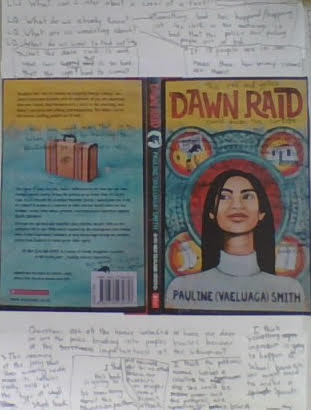Kia ora readaloud whanau,
My name is Finn and I am a part of the Room 13 whanau at Tamatea Intermediate. I am excited to be launching into our third readaloud text. I am sure that 'Dawn Raid' by Pauline (Vaeluaga) Smith will be amazing, especially because it is based on historical events from our past. I am also looking forward to using a website named wick editor to bring my inquires and ideas to life.
Yesterday, we analysed the front cover of the text. I noticed that the Polynesian Panthers may have an important role in the text because panthers can be seen all over the cover of the book - on the bar code, in the middle of the title, and down the side of the book. I am wondering how panthers can have anything to do with the story which is based here in New Zealand. What are your thoughts about this and why?
The blurb at the back of the text suggests that there is possibly a family holiday happening and that 18 members of the family are staying in one house. I'm wondering how they managed to fit 18 different people into one house. What are your thoughts about this and why?
The image of the suitcase for me suggests that Sofia's family have travelled to New Zealand and are perhaps immigrants. I also noticed that the label on the suitcase/stamp says Aotearoa instead of New Zealand so I am thinking that perhaps they are Pacific Islanders? What are your thoughts about the suitcase and why?
I think that the images depicted around Sofia's head have an important role to play in the story because they are highlighted in circles that connect to the patterns of the larger circle surrounding Sofia. I also think that the patterns further prove that the family are immigrants from the Pacific Islands.
The colours of the cover could have many meanings -
Yellow could indicate dawn approaching and it could also mean happiness. I think this because the blurb talked about being woken up at 4am in the morning in a state of chaos. The happiness could be spending family time together.
Red could indicate that the sun is reflected onto the clouds or perhaps that something more sinister is going to happen - bloodshed and fighting could be the meaning behind the red text.
The blue could indicate depression, sadness, and darkness but could also mean that the family has travelled over water. I am thinking this because the yellow is lighter than the blue.
I am still wondering about what the milk bottles and the boots are about.
I am also wondering why the police would arrive at someone's home and start pulling people out of bed and also how they managed to get in - did they break down the door?
I look forward to reading some of your thoughts about the cover of the text and cannot wait to see what you have done so far.
Here is a photo that shows some of my thinking from our learning so far. I look forward to seeing what everyone else has been learning about so far.

Hey there Finn it is Kerri here. I really enjoyed reading your post. Your cover analysis is very thorough. It is a great question about the image of the panther. You will find out through the story why it is so significant:) You will have to wait!
ReplyDeleteI agree, it must be difficult living in a house with this many people - especially if sometimes you don't get on with someone (like an annoying little brother or sister). On the other hand, it could also be a heap of fun - always someone to play games with aye.
Your thinking and ideas about the images on the cover are thoughtful. Yes the milk bottles are a thing of the past but an important part of this story as you will find out.
I love your ideas about the colour choices. You are doing some brilliant critical thinking.
Thank you for sharing the photo of your sketchnote book with the initial thinking - it is great for others to see how everyone is going about the pre-reading learning.
I look forward to reading more of what you have to share as we read through the story.
Wow, what a fantastic cover analysis! I read this to the Year 5/6 class at St Anthony's and they were impressed. It made for some great conversation.
ReplyDeleteTēna koe, Finn. We were inspired by your tuhinga and it helped us improve our own analyses of the pukapuka. Ngā mihi - thanks so much for sharing!
ReplyDelete